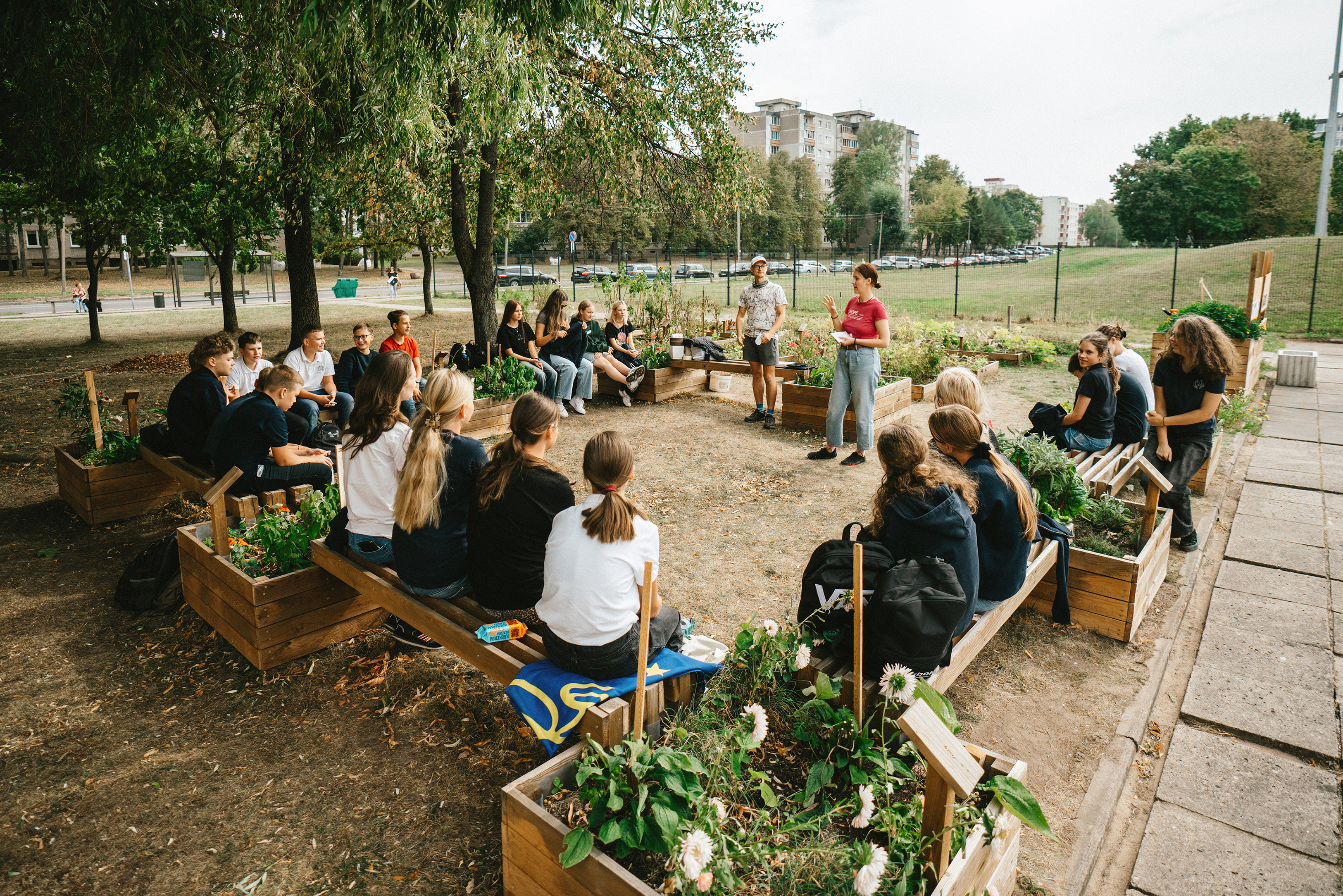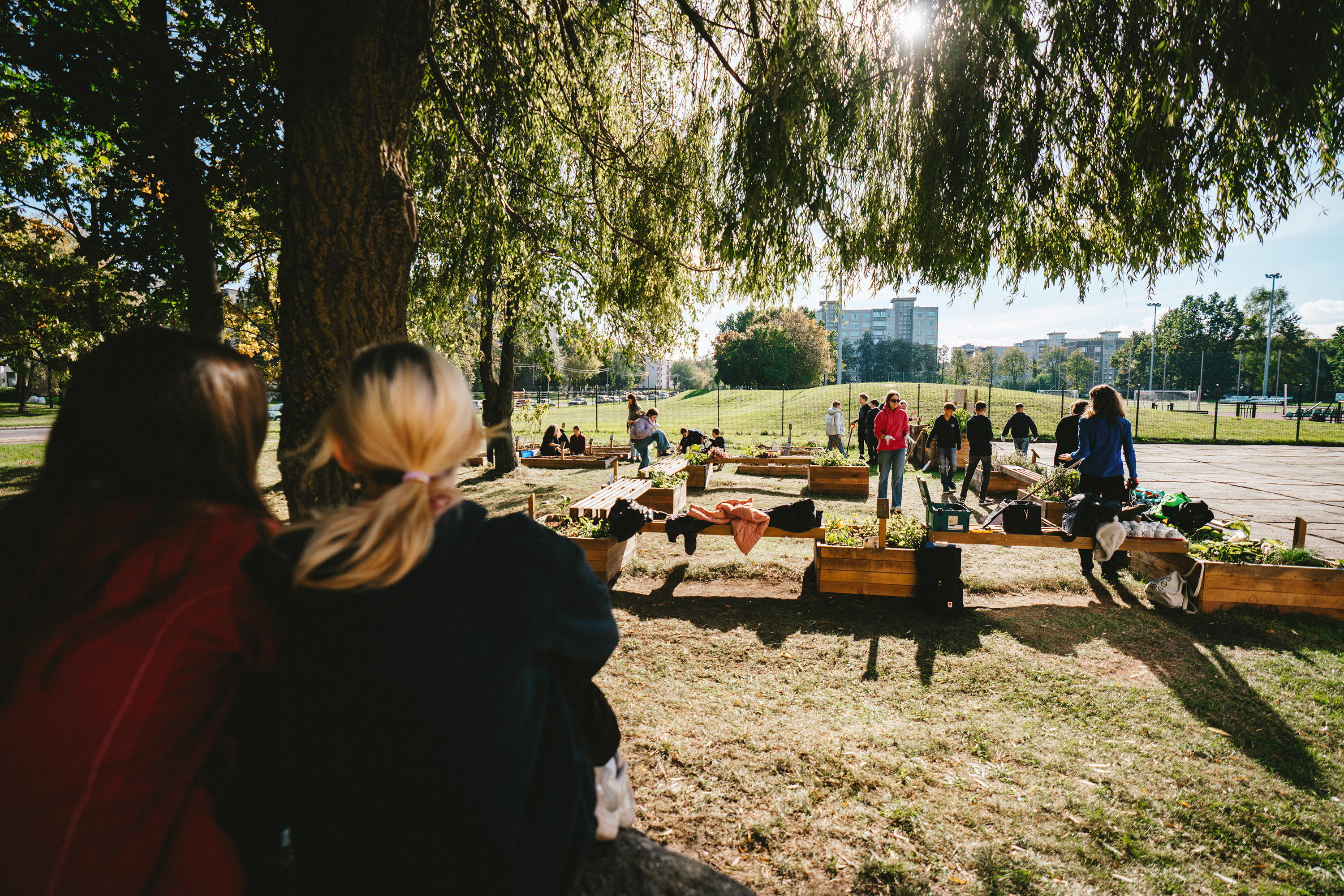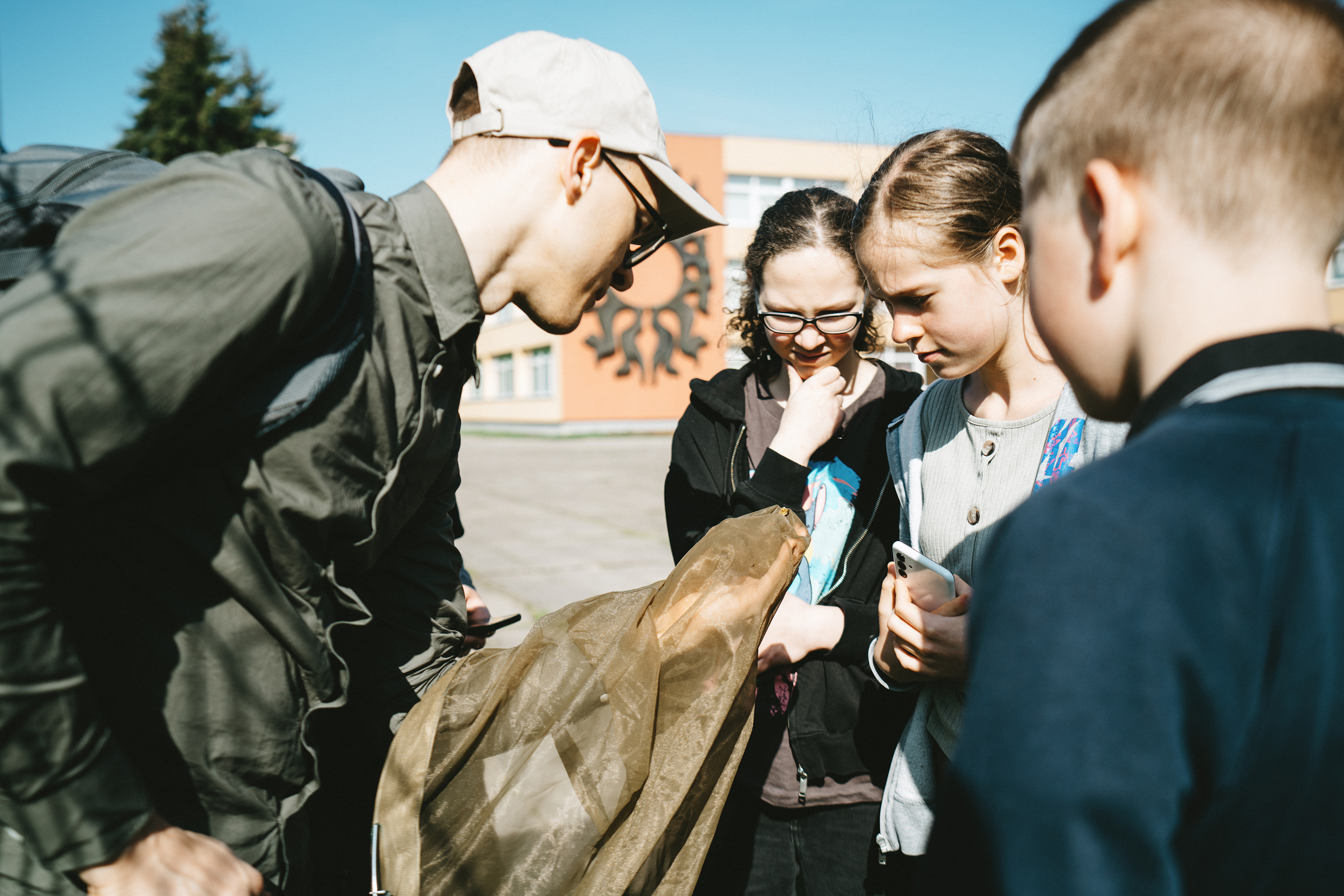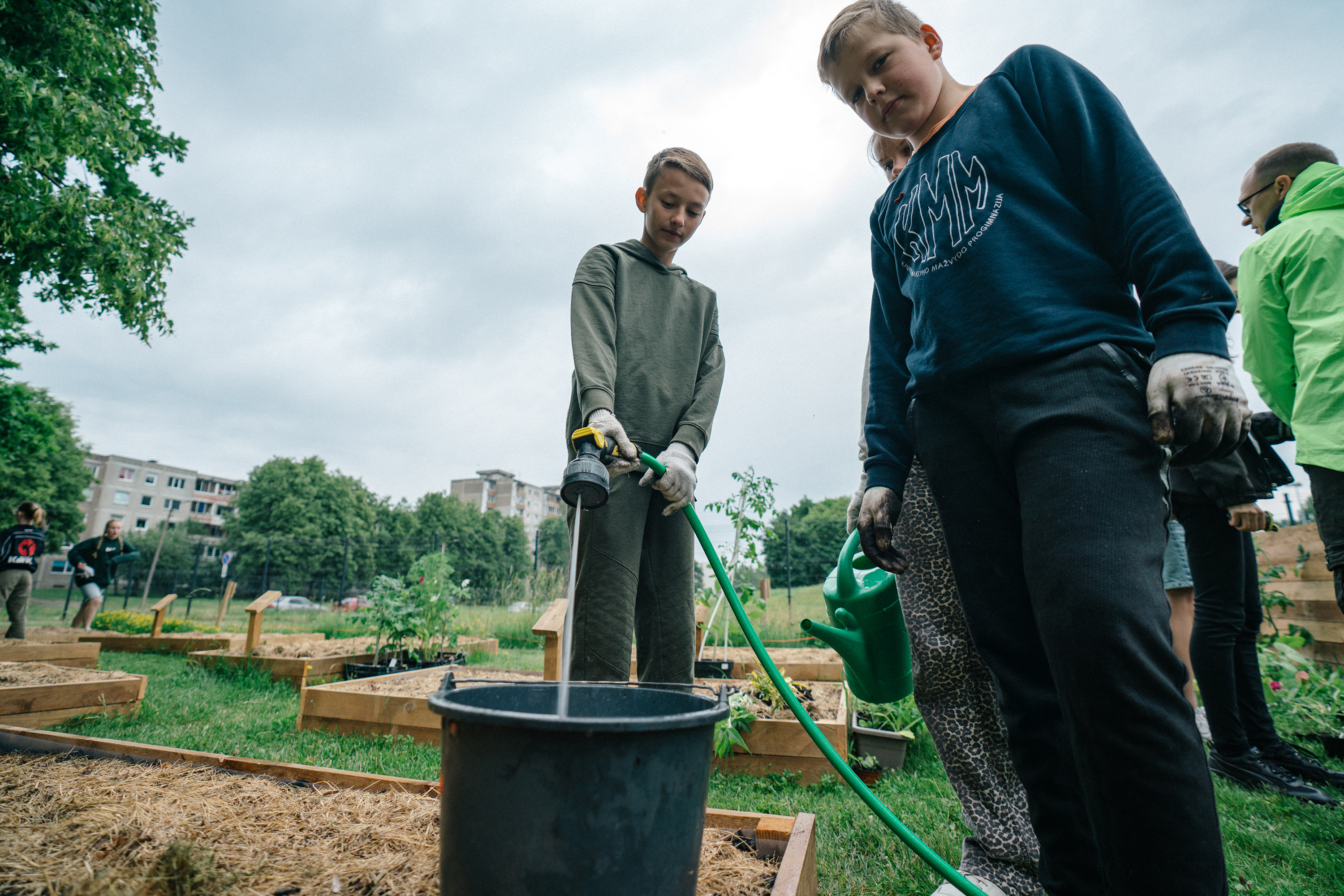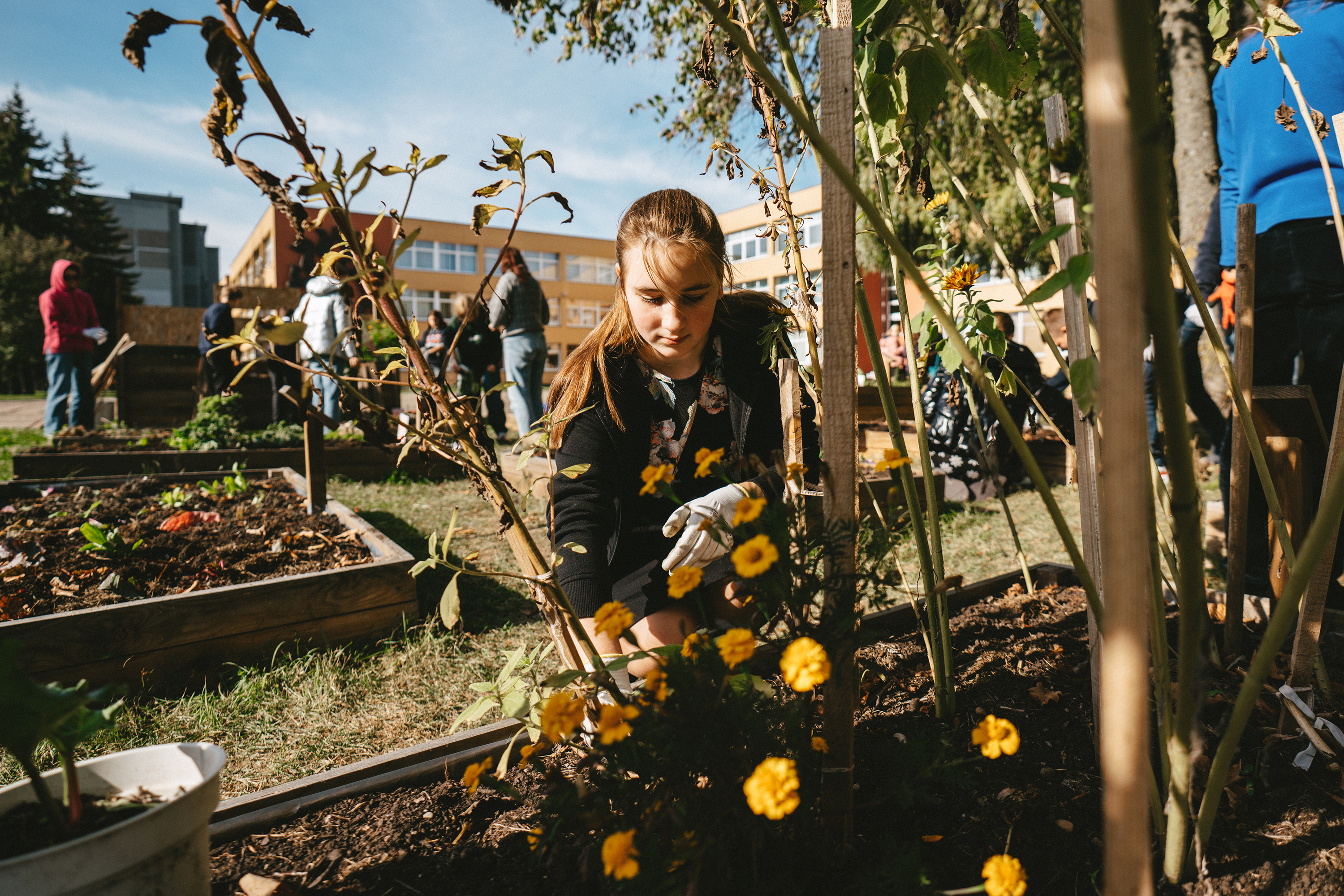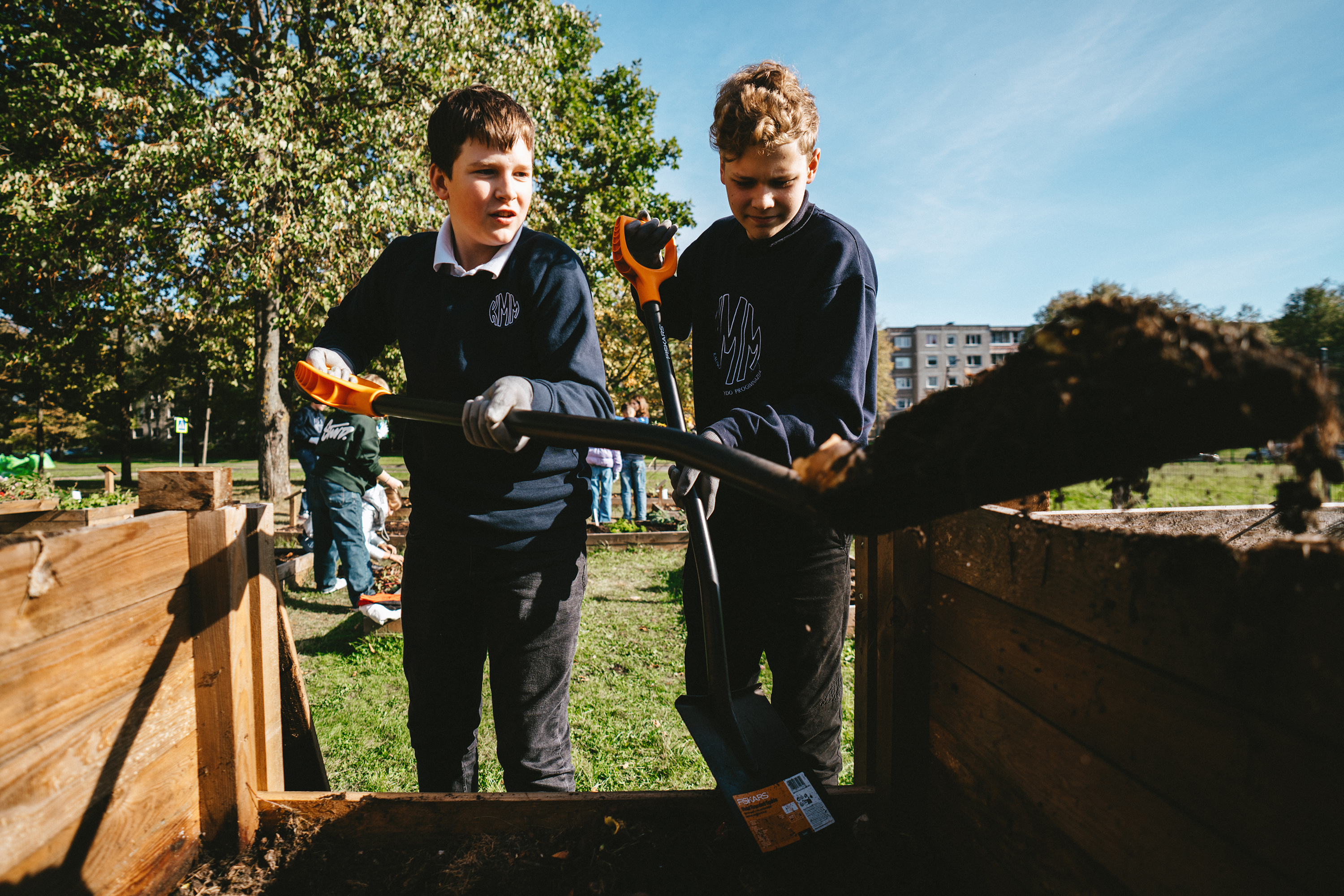Reconnecting with nature
Nature in the city experiential learning
Nature in the city - an experiential learning program addressing climate change through food webs
A hands-on educational program that reconnects intergenerational urban communities with nature. We do so by physical transformation of a neglected space into a public, and biodiverse, outdoor learning environment. Physical transformation is realised through 10 experiential learning sessions where participants discover relationships among biodiversity, climate change and food webs. Inspiring healthier cities, stronger communities, and holistic climate change action—one seed at a time!
Lithuania
Local
Kaunas
It addresses urban-rural linkages
It refers to a physical transformation of the built environment (hard investment)
Yes
2024-11-15
Yes
European Union LIFE programme
Reference: LIFE20 IPC/LT/000002
We participated in a hackathon organized under this project and received 20000 Eur for completing the pilot of our idea by 2024-11-15.
No
No
As a representative of an organisation
The project encourages intergenerational urban communities to reconnect with nature. Through a 10-session experiential program, participants explore biodiversity, climate change, and food webs, while actively transforming a neglected public space into an outdoor learning hub and biodiversity hotspot. This process fosters a deeper connection between people, food, and their community, providing a tangible way to understand their role in nature. The project was developed by a transdisciplinary team to ensure a holistic, regenerative urban solution.
Objectives:
- Provide hands-on learning on biodiversity, climate change, and food webs.
- Transform a neglected space into an outdoor learning space.
- Strengthen intergenerational connections.
- Promote climate action.
- Enhance urban biodiversity.
- Inspire others to take action.
Target Groups:
- Core group (up to 30 people) with ownership or agency to care for urban land.
- Wider community members.
- Local residents: individuals who discover and use the transformed space.
- Urban planners and officials who can create a network of similar spaces.
Achieved Outcomes:
- Nature integrated into daily life and learning.
- Enhanced biodiversity through native meadows and no-mow experiments.
- Opportunities for relaxation, physical activity, and social interaction.
- Stronger community sense of agency in public space.
- Nature-based solutions introduced into Lithuanian schools.
- Increased climate awareness.
The project received significant public support, winning the "Green Lithuania" award, presented by the President. The project integrates NEB values, transforming public spaces into green areas with art, cultural events, and intergenerational learning, fostering community participation. It addresses urbanization, climate change, and social fragmentation, revitalizing spaces, enhancing food security, and promoting social cohesion, while offering a scalable model.
Objectives:
- Provide hands-on learning on biodiversity, climate change, and food webs.
- Transform a neglected space into an outdoor learning space.
- Strengthen intergenerational connections.
- Promote climate action.
- Enhance urban biodiversity.
- Inspire others to take action.
Target Groups:
- Core group (up to 30 people) with ownership or agency to care for urban land.
- Wider community members.
- Local residents: individuals who discover and use the transformed space.
- Urban planners and officials who can create a network of similar spaces.
Achieved Outcomes:
- Nature integrated into daily life and learning.
- Enhanced biodiversity through native meadows and no-mow experiments.
- Opportunities for relaxation, physical activity, and social interaction.
- Stronger community sense of agency in public space.
- Nature-based solutions introduced into Lithuanian schools.
- Increased climate awareness.
The project received significant public support, winning the "Green Lithuania" award, presented by the President. The project integrates NEB values, transforming public spaces into green areas with art, cultural events, and intergenerational learning, fostering community participation. It addresses urbanization, climate change, and social fragmentation, revitalizing spaces, enhancing food security, and promoting social cohesion, while offering a scalable model.
Biodiversity
Climate change
Food webs
Community
Experiential learning
The project is a forward-thinking response to climate challenges, using urban food networks as a tool for environmental and social transformation. A key objective is to create living laboratories—dynamic public spaces where sustainability principles are learned through direct experience. By integrating urban greening with food production, composting, and biodiversity initiatives, the project turns cities into hands-on classrooms for climate resilience. The project’s approach ensures that school communities and the wider neighborhood can actively engage in sustainable practices. Schools serve as hubs where students, families, and elderly residents come together to learn about food cycles, soil health, and urban ecology. Workshops, gardening sessions, and seasonal events foster intergenerational exchange, ensuring that traditional knowledge merges with innovative environmental solutions. By a simple and modular solution, designed for easy disassembly and repair, the project ensures, not only longevity of the learning space, but also effective scalability through a possibility of a guided DIY model. The space establishment and 10 session program can be implemented independently of each other, widening the possibilities for adaptation and reach of the project in different contexts.
This project reimagines the urban environment as a multi-sensory, interactive space where people of all ages can experience nature through touch, taste, and smell. By transforming neglected urban corners into edible landscapes, it provides a high-quality experience that blends ecological function with beauty and cultural significance. The initiative goes beyond aesthetics—it creates immersive learning environments where the design of green spaces actively supports experiential education. Outdoor classrooms, sensory gardens, and biodiversity hubs provide students, families, and older generations opportunities to engage in shared activities such as growing food, seed saving, and composting. Art and design elements, including community-built structures and educational signage, make sustainability concepts more tangible and engaging. The project also emphasizes cultural heritage by integrating traditional agricultural practices with modern ecological principles. By reviving native plant species and traditional food-growing methods, it reconnects urban dwellers with historical knowledge while preparing them for a sustainable future. This holistic approach sets a benchmark for integrating high-quality design, education, and sustainability, proving that public spaces can be both visually inspiring and function as community learning hubs.
Inclusion is at the heart of the project, ensuring that green, educational spaces are accessible and beneficial for all generations, social groups, and abilities. A nested inclusion/participation model is applied in this project. There are at least 4 inclusion layers in the first prototype, layer by layer, widening participation from 30 core group members to limitless and broad, decentralised work reaching beyond the created physical space. By embedding learning opportunities into public spaces, it also removes financial and social barriers, making sustainability education available not only to students but also to parents, senior citizens, and marginalized communities. This cross-generational learning strengthens community ties and cultivates a sense of belonging, proving that sustainability is a shared responsibility. By transforming urban green spaces into places of shared learning, social interaction, and ecological stewardship, this project is a model for inclusive, education-driven urban regeneration that strengthens communities and builds resilient, knowledge-based societies.
The project places citizens at the center of urban transformation, ensuring that local communities directly benefit from, shape, and sustain its impact. By integrating experiential learning, urban greening, and food networks, the project enhances the well-being of residents while fostering environmental responsibility. Citizens benefit in multiple ways:
- Educational Impact: Schools, families, and local communities engage in hands-on learning experiences through workshops on urban gardening, composting, and food sustainability.
- Health & Well-being: The creation of green spaces improves air quality, promotes physical activity, and provides stress-reducing natural environments.
- Social Cohesion: Intergenerational activities strengthen community ties, fostering relationships between students, parents, and elderly residents who share knowledge and skills.
- Economic & Food Security: Community gardens offer affordable access to fresh produce, reducing reliance on industrial food supply chains and strengthening local economies.
The high level of involvement in establishment of the space and engagement with new content has led to a sense of shared ownership, making the project more resilient and impactful over time. By the end of the program, the community is the ultimate owner and steward of the place with new ideas and experience to enter the next yearly cycle.
- Educational Impact: Schools, families, and local communities engage in hands-on learning experiences through workshops on urban gardening, composting, and food sustainability.
- Health & Well-being: The creation of green spaces improves air quality, promotes physical activity, and provides stress-reducing natural environments.
- Social Cohesion: Intergenerational activities strengthen community ties, fostering relationships between students, parents, and elderly residents who share knowledge and skills.
- Economic & Food Security: Community gardens offer affordable access to fresh produce, reducing reliance on industrial food supply chains and strengthening local economies.
The high level of involvement in establishment of the space and engagement with new content has led to a sense of shared ownership, making the project more resilient and impactful over time. By the end of the program, the community is the ultimate owner and steward of the place with new ideas and experience to enter the next yearly cycle.
The project creates ripple effects, starting with a core group of up to 30 people who have ownership or agency over a publicly accessible urban space. In our prototype, this group consisted of 6th-7th graders and their teachers in a Soviet-era housing estate. They participated in all learning sessions and played a key role in transforming the space.
The first ripple effect engaged the school community, inviting students, teachers, and families to three working sessions to help with the transformation. The second ripple occurred when local residents discovered and began using the space. Informative materials and invitations encouraged ongoing care, ensuring its role as a community hub—especially vital during summer when the core group was absent. In our prototype, residents embraced the space, using it daily.
The third ripple reached designers and decision-makers, inspiring networks of similar spaces in cities. National and EU funding enabled the prototype, and its impact was recognized when we won the national Green Lithuania category of The Power of Lithuania initiative in November 2024, awarded by the President. This honor validates the project’s innovative, community-driven approach and sparks conversations with urban planners and policymakers about replicating the model for sustainable urban transformation.
Success relied on engagement at all levels. The program’s design and implementation ran in parallel over 10 months, with facilitators undergoing 10 iterative cycles—continuously refining sessions based on reflections and insights.
The first ripple effect engaged the school community, inviting students, teachers, and families to three working sessions to help with the transformation. The second ripple occurred when local residents discovered and began using the space. Informative materials and invitations encouraged ongoing care, ensuring its role as a community hub—especially vital during summer when the core group was absent. In our prototype, residents embraced the space, using it daily.
The third ripple reached designers and decision-makers, inspiring networks of similar spaces in cities. National and EU funding enabled the prototype, and its impact was recognized when we won the national Green Lithuania category of The Power of Lithuania initiative in November 2024, awarded by the President. This honor validates the project’s innovative, community-driven approach and sparks conversations with urban planners and policymakers about replicating the model for sustainable urban transformation.
Success relied on engagement at all levels. The program’s design and implementation ran in parallel over 10 months, with facilitators undergoing 10 iterative cycles—continuously refining sessions based on reflections and insights.
The project is rooted in an interdisciplinary approach, merging expertise from various fields to create a holistic and innovative model for urban resilience. Key disciplines involved include:
Ecology & Environmental Science: Biologist ensures that the project enhances biodiversity, soil health, and urban climate adaptation through evidence-based interventions.
Youth work: Youth worker ensures that activities, games and tasks are just enough challenging for the age group.
Education & Pedagogy: Teachers integrating sustainability topic and outdoor learning into curricula and regular lectures.
Landscape Architecture & Urban Design: Designer creates multifunctional green space that is both aesthetically pleasing and highly functional for learning and social engagement.
Social Sciences & Community Engagement: facilitation expert ensures inclusivity by addressing social dynamics, accessibility, and participatory governance.
Art & Cultural Heritage: Artist implements placemaking, ensuring that green spaces are not only sustainable but also culturally significant and visually inspiring.
Collaboration among these disciplines occurs through co-creation workshops, and ongoing knowledge exchange. This approach fosters innovation, adaptability, and deeper community engagement, ensuring that the project is scientifically grounded, socially inclusive, and culturally meaningful. The added value of this process is a well-rounded, replicable model that integrates environmental sustainability with education, social impact, and urban design. By uniting multiple disciplines, the project demonstrates how cities can transform into living, learning environments for all generations.
Ecology & Environmental Science: Biologist ensures that the project enhances biodiversity, soil health, and urban climate adaptation through evidence-based interventions.
Youth work: Youth worker ensures that activities, games and tasks are just enough challenging for the age group.
Education & Pedagogy: Teachers integrating sustainability topic and outdoor learning into curricula and regular lectures.
Landscape Architecture & Urban Design: Designer creates multifunctional green space that is both aesthetically pleasing and highly functional for learning and social engagement.
Social Sciences & Community Engagement: facilitation expert ensures inclusivity by addressing social dynamics, accessibility, and participatory governance.
Art & Cultural Heritage: Artist implements placemaking, ensuring that green spaces are not only sustainable but also culturally significant and visually inspiring.
Collaboration among these disciplines occurs through co-creation workshops, and ongoing knowledge exchange. This approach fosters innovation, adaptability, and deeper community engagement, ensuring that the project is scientifically grounded, socially inclusive, and culturally meaningful. The added value of this process is a well-rounded, replicable model that integrates environmental sustainability with education, social impact, and urban design. By uniting multiple disciplines, the project demonstrates how cities can transform into living, learning environments for all generations.
The project stands out as a highly innovative approach to urban sustainability. Unlike mainstream urban greening initiatives, which often focus solely on aesthetics or environmental benefits, this project integrates experiential learning, intergenerational exchange, and circular food systems into public space transformation. Key innovations include:
- Living Classrooms & Experiential Learning: Instead of treating green spaces as passive infrastructure, the project turns them into interactive, outdoor educational spaces.
- Intergenerational Knowledge Exchange: The project bridges generations by involving elderly residents in knowledge-sharing with younger generations. Older citizens contribute traditional agricultural practices, while younger participants introduce innovative sustainability solutions, fostering a two-way learning process.
- Food Networks as Climate Solutions: While many urban sustainability projects focus on reforestation or carbon offsetting, this initiative leverages food systems to address climate adaptation. By integrating urban agriculture, composting, and food-sharing networks, it strengthens local resilience and reduces food waste.
- Citizen-Driven Design: Unlike top-down greening strategies, the project empowers communities to co-create and maintain their urban spaces. Residents take an active role in shaping, managing, and benefiting from the project, leading to stronger ownership and long-term impact.
- Scalability & Replicability: The methodology is designed to be easily adapted to different urban contexts, making it a scalable model for European cities seeking inclusive, climate-resilient public space solutions.
By combining education, ecology, and social inclusion, this project redefines how cities approach sustainability—not just as an environmental necessity but as an opportunity for civic engagement, lifelong learning, and social innovation.
- Living Classrooms & Experiential Learning: Instead of treating green spaces as passive infrastructure, the project turns them into interactive, outdoor educational spaces.
- Intergenerational Knowledge Exchange: The project bridges generations by involving elderly residents in knowledge-sharing with younger generations. Older citizens contribute traditional agricultural practices, while younger participants introduce innovative sustainability solutions, fostering a two-way learning process.
- Food Networks as Climate Solutions: While many urban sustainability projects focus on reforestation or carbon offsetting, this initiative leverages food systems to address climate adaptation. By integrating urban agriculture, composting, and food-sharing networks, it strengthens local resilience and reduces food waste.
- Citizen-Driven Design: Unlike top-down greening strategies, the project empowers communities to co-create and maintain their urban spaces. Residents take an active role in shaping, managing, and benefiting from the project, leading to stronger ownership and long-term impact.
- Scalability & Replicability: The methodology is designed to be easily adapted to different urban contexts, making it a scalable model for European cities seeking inclusive, climate-resilient public space solutions.
By combining education, ecology, and social inclusion, this project redefines how cities approach sustainability—not just as an environmental necessity but as an opportunity for civic engagement, lifelong learning, and social innovation.
The project is based on a holistic, participatory, and interdisciplinary methodology that ensures both ecological impact and deep community involvement. We call it regenerative placemaking and it involves at least 3 learning loops, each consisting of 3 parallel strings of activities. The 3 parallel strings of activities can also be understood as core principles:
- Listening - This involves understanding multiple contexts in a specific place. Here we focus on “landing” and “grounding” global phenomena and scientific theories into the place. We learn from multiple sources and experts to have a broad understanding of the current situation.
- Experimenting - This involves hands-on activities, engagement with the real works through all our senses and taking action in public space. This is done in a co-creative and participatory manner ensuring the fostering of active citizenship.
- Learning - This involves learning to observe our feelings, emotions, experiences and practicing to voice them to other people, as well as, practicing listening skills in hearing other peoples experiences without judgment. It also involves building observation skills to evaluate the success of experiments, and prepare for the next cycle.
Physical transformation is never a goal in itself in regenerative placemaking. Often regenerative placemaking starts by examining our worksviews and revealing the collective story of the place. Only then when we know what is the story we are telling ourselves we start thinking about changes that we need to make to make the story a story of regeneration.
This project evolved through this methodology, because we discovered that urban gardening in Lithuania is being systematically destroyed and without physical interventions in Lithuanian cities this practice will disappear very soon. This methodology ensures that sustainability is not just an abstract goal but a tangible, everyday experience.
- Listening - This involves understanding multiple contexts in a specific place. Here we focus on “landing” and “grounding” global phenomena and scientific theories into the place. We learn from multiple sources and experts to have a broad understanding of the current situation.
- Experimenting - This involves hands-on activities, engagement with the real works through all our senses and taking action in public space. This is done in a co-creative and participatory manner ensuring the fostering of active citizenship.
- Learning - This involves learning to observe our feelings, emotions, experiences and practicing to voice them to other people, as well as, practicing listening skills in hearing other peoples experiences without judgment. It also involves building observation skills to evaluate the success of experiments, and prepare for the next cycle.
Physical transformation is never a goal in itself in regenerative placemaking. Often regenerative placemaking starts by examining our worksviews and revealing the collective story of the place. Only then when we know what is the story we are telling ourselves we start thinking about changes that we need to make to make the story a story of regeneration.
This project evolved through this methodology, because we discovered that urban gardening in Lithuania is being systematically destroyed and without physical interventions in Lithuanian cities this practice will disappear very soon. This methodology ensures that sustainability is not just an abstract goal but a tangible, everyday experience.
The project is designed to be highly adaptable and scalable, making it applicable to diverse urban contexts, groups of beneficiaries, and geographic locations. Key elements that can be replicated or transferred include:
- Regenerative placemaking methodology.
- The physical space design.
- The principles of designing and positioning the learning environment in public space.
- The logic of the 10 session process.
- The content of 10 sessions, with modifications, could work in many different contexts.
We prototyped the project with a school community but this can be applicable to any kind of group of people who want to contribute to their living or working environment and surrounding community. Projects can be implemented by any kind of public or private institution. The only criteria for replicability that we would impose is that, if a physical space is created, it must be publicly accessible to increase impact and benefits.
The project’s strength lies in its low-cost, high-impact approach—by using nature-based solutions, citizen engagement, and experiential learning, it maximizes impact with minimal resources. This makes it an ideal model for cities looking to integrate sustainability into public spaces without large-scale infrastructure investments.
- Regenerative placemaking methodology.
- The physical space design.
- The principles of designing and positioning the learning environment in public space.
- The logic of the 10 session process.
- The content of 10 sessions, with modifications, could work in many different contexts.
We prototyped the project with a school community but this can be applicable to any kind of group of people who want to contribute to their living or working environment and surrounding community. Projects can be implemented by any kind of public or private institution. The only criteria for replicability that we would impose is that, if a physical space is created, it must be publicly accessible to increase impact and benefits.
The project’s strength lies in its low-cost, high-impact approach—by using nature-based solutions, citizen engagement, and experiential learning, it maximizes impact with minimal resources. This makes it an ideal model for cities looking to integrate sustainability into public spaces without large-scale infrastructure investments.
The project tackles some of the most pressing global challenges by implementing locally grounded, citizen-driven solutions. It demonstrates that global challenges can be tackled effectively when solutions are community-driven, interdisciplinary, and deeply integrated into daily life. Key issues addressed include:
Climate Change & Urban Resilience
By increasing green cover in cities, the project helps reduce urban heat islands, improve air quality, and enhance climate adaptation. The focus on biodiversity-friendly urban spaces supports pollinators and other essential species, reinforcing ecological balance.
Food Security & Sustainable Consumption
The project localises food systems, reducing reliance on long food supply chains and decreasing carbon emissions linked to food transport. Community gardens and food-sharing networks provide affordable, fresh produce, addressing food insecurity in urban areas.
Educational & Social Inequality
Sustainability education is often limited to privileged communities, but this project democratizes access to hands-on environmental learning by integrating it into public spaces. The intergenerational learning model ensures that knowledge is passed across generations, reinforcing social ties and inclusivity.
Biodiversity Loss & Soil Degradation
By transforming neglected urban areas into regenerative green spaces, the project improves soil health, restores local ecosystems, and promotes native plant species.
Civic Engagement & Participatory Urbanism
Many urban development projects exclude citizens from decision-making, but this initiative empowers local communities to shape their environment through participatory design. It fosters a sense of ownership and responsibility, making sustainability a shared, everyday practice rather than a top-down policy.
Climate Change & Urban Resilience
By increasing green cover in cities, the project helps reduce urban heat islands, improve air quality, and enhance climate adaptation. The focus on biodiversity-friendly urban spaces supports pollinators and other essential species, reinforcing ecological balance.
Food Security & Sustainable Consumption
The project localises food systems, reducing reliance on long food supply chains and decreasing carbon emissions linked to food transport. Community gardens and food-sharing networks provide affordable, fresh produce, addressing food insecurity in urban areas.
Educational & Social Inequality
Sustainability education is often limited to privileged communities, but this project democratizes access to hands-on environmental learning by integrating it into public spaces. The intergenerational learning model ensures that knowledge is passed across generations, reinforcing social ties and inclusivity.
Biodiversity Loss & Soil Degradation
By transforming neglected urban areas into regenerative green spaces, the project improves soil health, restores local ecosystems, and promotes native plant species.
Civic Engagement & Participatory Urbanism
Many urban development projects exclude citizens from decision-making, but this initiative empowers local communities to shape their environment through participatory design. It fosters a sense of ownership and responsibility, making sustainability a shared, everyday practice rather than a top-down policy.
Results:
- 10-session educational program (40 contact hours)
- 250 participants
- 170 m² outdoor educational space created
Outcomes:
- Outdoor classrooms enable hands-on learning in ecology, sustainability, and climate resilience.
- Schools integrate nature-based learning into curricula, fostering environmental awareness.
- Public workshops teach composting, urban farming, and regenerative gardening.
- Underutilized urban areas are transformed into green spaces supporting biodiversity.
Impacts:
- Biodiversity-friendly landscapes improve environmental quality with edible gardens, pollinator meadows, and rain-absorbing greenery.
- Accessible green spaces enhance relaxation, recreation, and social connection.
- Increased sense of ownership and responsibility for local environments.
- Strengthened human-nature connection.
Benefits for Direct Beneficiaries:
- Students and teachers gain enriched learning experiences in nature.
- Residents enjoy cleaner air, more green spaces, and social interaction.
- Elderly citizens mentor younger generations, promoting active aging.
- Schools and community groups gain tools for environmental education.
Benefits for Indirect Beneficiaries:
- Urban planners gain a scalable model for nature-based city design.
- Neighborhoods benefit from green infrastructure and local food production.
- The global sustainability community gains a replicable model for climate-resilient, inclusive cities.
- 10-session educational program (40 contact hours)
- 250 participants
- 170 m² outdoor educational space created
Outcomes:
- Outdoor classrooms enable hands-on learning in ecology, sustainability, and climate resilience.
- Schools integrate nature-based learning into curricula, fostering environmental awareness.
- Public workshops teach composting, urban farming, and regenerative gardening.
- Underutilized urban areas are transformed into green spaces supporting biodiversity.
Impacts:
- Biodiversity-friendly landscapes improve environmental quality with edible gardens, pollinator meadows, and rain-absorbing greenery.
- Accessible green spaces enhance relaxation, recreation, and social connection.
- Increased sense of ownership and responsibility for local environments.
- Strengthened human-nature connection.
Benefits for Direct Beneficiaries:
- Students and teachers gain enriched learning experiences in nature.
- Residents enjoy cleaner air, more green spaces, and social interaction.
- Elderly citizens mentor younger generations, promoting active aging.
- Schools and community groups gain tools for environmental education.
Benefits for Indirect Beneficiaries:
- Urban planners gain a scalable model for nature-based city design.
- Neighborhoods benefit from green infrastructure and local food production.
- The global sustainability community gains a replicable model for climate-resilient, inclusive cities.

